
相手の「学習」を導くパートナーになるために
前回の記事では、人が成長するメカニズムについて、「自己成長力(経験から学ぶ力)」に注目をしながらお話しました。そして、部下の育成に関わる場合、部下の自己成長力をどのように伸ばすかが大切であるという点をお伝えいたしました。
ここまでのいわば「土台づくり」ができたら、いよいよ具体的な支援のスタートです。ここから先については、部下の適応課題に対処することを想定したいと思います。技術課題への対応も大切なことではありますが、この点については部下育成に関する書籍に関われていることも多くありますので、そちらに譲りたいと思います。
部下の適応課題に向き合い、共に対処していくプロセスは、長い道のりになります。また「これをやれば解決できる」という手法もありません。(それがあるなら「適応課題」ではなく「技術課題」になるでしょう)
部下の適応課題に向き合うためには、その適応課題を乗り越えるまでのストーリーをイメージしておくことが大切になります。
今後のストーリーを予見する
「適応課題を乗り越える」とは、うまくいかない矛盾を抱えた状態で葛藤を乗り越えるプロセスに他なりません。矛盾の内容は人によっても場面によっても異なりますが、乗り越えるストーリーには共通のものがあると私は考えています。
そのストーリーを表す一つの原型が、神話学者ジョセフ・キャンベル氏の「英雄の旅」です。「世界各地の神話には共通するパターンがある」というもので、その内容は次の図のようになります。

このストーリーの原型を参考にすると、どのようにプロセスを経て適応課題を超えていくのか、その過程にはどのような試練がありそうか、その試練を乗り越えるためにはどのような環境や支援が必要なのかをイメージしやすくなると思います。より詳しく知りたい方は、次の記事も参考にしてみてください。
もちろん、イメージした通りに物事が進むわけではありませんし、その通りにコントロールすべきという話ではありません。それでも、いま「旅」全体のどのあたりにいて、今後どのような局面がありそうかを俯瞰して捉えておくことで、近視眼的にならずに部下を望ましい方向へと自然な形で導きやすくなります。
経験学習サイクル
「英雄の旅」によって部下の成長ストーリーをイメージしておくというのは、マクロ的・俯瞰的な捉え方と言えます。
よりミクロな働きかけとしては、本人の「経験と問い」をデザインすることが大切です。そのためには「経験学習サイクル」という考え方を理解しておくことが有用です。
経験学習サイクルとは、先行研究をもとにKolbによって再構成された学習モデルであり、主観化と客観化、具体化と抽象化の二軸から構成された4つの要素が循環的に進むことによって学習が促されるというものです。
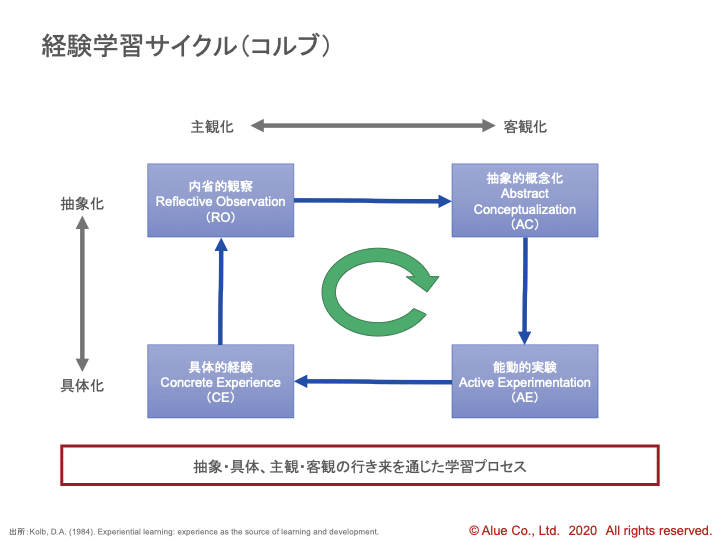
経験学習サイクルが機能しているとき、次のようなプロセスが回っています。
「主観×具体」(左下)
実際に何かの出来事を経験し、その際の感覚や想いを主観的に捉える
↓
「主観×抽象」(左上)
具体的な経験を内省し、自分にとっての意味づけを与える
↓
「客観×抽象」(右上)
起きた出来事の因果関係を把握したり、成功ストーリーや失敗ストーリーをパターン化するなど、応用可能な示唆を得る
↓
「客観×具体」(右下)
仮説としての示唆を実体験の中で検証する
↓
「主観×具体」(左下)
そこで得られた経験をまた主観的に捉える
↓
・・・
部下の学習スタイルに合わせてサポートする
経験学習サイクルは、サイクルという名前の通り、4つの象限をなるべく偏りなく回していくことが重要です。しかしながら、人にはそれぞれの学習スタイルがあり、この4つの象限の中でも強い部分(自然と実践できる部分)と弱い部分(自然には実践できない部分)があります。例として次の図で4種類のタイプを示しました。
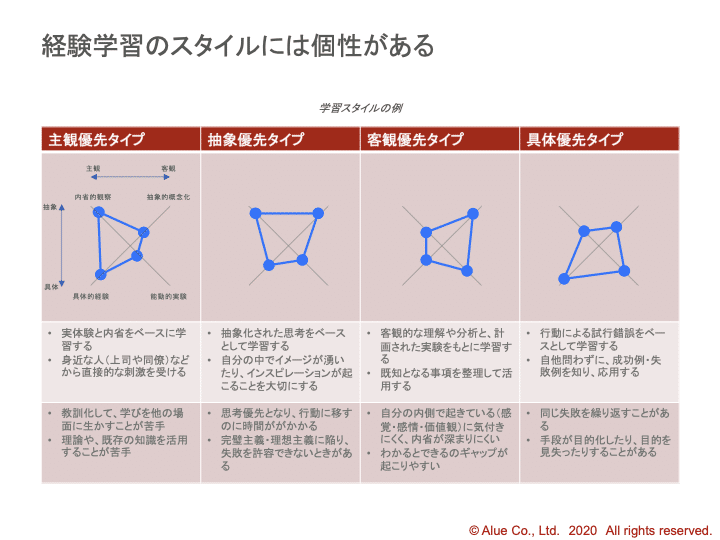
みなさんは、どのタイプに近いでしょうか。私は抽象優先タイプです。内省的観察や抽象的概念化は普段から何気なく実践できる一方で、行動に移すのに時間がかかったり、完璧主義に陥り失敗を許容できないこと場面があったりします。
人材育成においては、育成対象者がどのタイプかを観察し、なるべくバランスがよくなるように支援していきます。
たとえば「主観優先タイプ」の場合、過去の経験を抽象化して捉えるための支援をします。対話の中で投げかけてもいいですし、経験とそこからの学びを書き出すことを習慣化してもらうといった取り組みも有効です。
あるいは「抽象優先タイプ」であれば、具体的な行動を増やす後押しをします。「学びのための実験なのだから失敗しても何の問題もないよ」などとハードルを下げる働きかけも有効でしょう。

経験学習における「問い」の重要性
経験学習を効果的に促すために「問い」をもつことが重要です。
「問い」は、経験学習の目的と密接に関連しています。例えばお客様から真のニーズを聴くことに課題意識を持っている人であれば「どうすればお客様の真のニーズや想いを受け取れるのか?」のように、ありたい姿や願いにつながった探究内容を、なるべく具体的な問いの形に落とし込みます。
「問い」がはっきりしていると、日々の経験を通じて情報を受け取るセンサーが高まり、経験学習サイクルが回りやすくなります。経験学習サイクルの中で「問い」を位置づけるとすれば、サイクルの真ん中にあるイメージです。
具体的な支援としては、どのような「問い」を持ちながら、仕事に臨むのかについて、部下と対話をすると良いでしょう。「場面」と「問い」をセットにして明確にしておくとわかりやすいかもしれません。先程の例でいえば、「お客様との商談の場面」において、「どうすればお客様の真のニーズや想いを受け取れるのか」とう問いを持ちながら臨むということを部下と対話をしながら明確にしていきます。
経験学習サイクルが回ってくると徐々に「問い」への答えが見えてきます。そのようになったら、また次の「問い」を立てます。「問い」は常に進化していくものとして考え、「現時点の『問い』はなにか?」について部下に自覚的になってもらうことが重要です。
経験学習の「深さ」
さらに、経験学習のプロセスには「深さ」の視点もあります。初めは「点」だったものが「線・面・立体」としてより多面的・全体的になっていくイメージです。
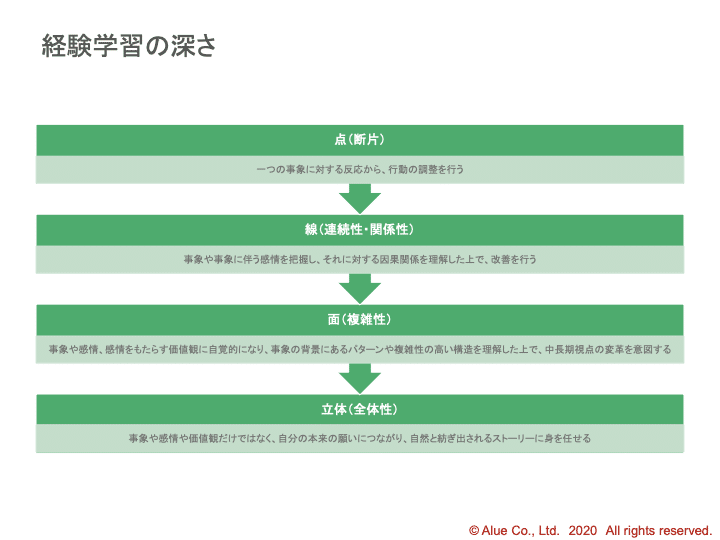
ここでは「お客さんからクレームがあった」という経験を例にとって、そこからの「学習の深さ」を考えてみましょう。
「点(断片)」の学習としては「ミスをなくすように努力する」というものが挙げられます。経験から直接の学びを得るイメージです。
一段深い「線(連続性・関係性)」では、たとえば「ミスが起きないように業務を標準化する」のような学習が起きます。「ミスが起きた」という経験の経緯を「線」(この場合は因果関係)で捉えています。
さらに深い「面(複雑性)」では、たとえば「オペレーションを軽視する組織文化を見直す」のような学習になります。現象の背景を構造的に捉え、根本原因となっている「価値観」まで含めて自覚するのです。
「願い」とのつながりで経験を捉える
「点・線・面」レベルの経験学習は、物事を「外の現象」として、あくまで客観的に捉えていました。しかし「立体」レベルの経験学習では、「願い」つまり「自分が心から望むもの」とのつながりの中で「外の現象」を捉えます。
例えば、私自身の「願い」の一つに「社員が幸せに働ける状態をつくる」というものがあります。ですから、何かの課題解決の際に「社員の幸せが犠牲になる」ような手段は、容認することができません。
先の例で「オペレーションを軽視する組織文化」というものが問題であるとわかった場合に、それが自分の価値観のどこから派生しているのか振り返ることが必要になります。私の場合は、「まずは試しにやってみる」という考え方がありました。トライアンドエラーを良しとすることで、オペレーションや体制が十分に整っていない状況であっても、そのままトライアンドエラーを続けることを良しとしてしまっている側面がありました。
しかし、この考え方が、「社員が幸せに働ける状態をつくる」ことに反してしまっていることに気づきます。そのときに、どちらの方が、自分の本当の願いなのかを考え、本当の願いを優先し、そうではないものは変更する必要があります。
通常「価値観」を変えることは容易ではありませんが、自分の「願い」を自覚していると、「価値観」を変えることを厭わなくなるのです。

ですから、価値観レベルの変容が必要な適応課題に向き合うときには、経験学習の深さとしては「面」というレベルで捉えることを基本としながら、ときには「立体」というレベルで捉えることも必要となります。
今回の記事では、部下の「学習」を導くパートナーとなるために、部下が経験学習サイクルを回すための支援をしていくこと大切さと、その方法についてお話しました。
本日の問いとなります。(よろしければ、コメントにご意見ください)
・あなたの部下や後輩の学習スタイルは、以下のどのタイプに近いでしょうか?(部下や後輩がいない場合は、自分のスタイルを考えてみてください)
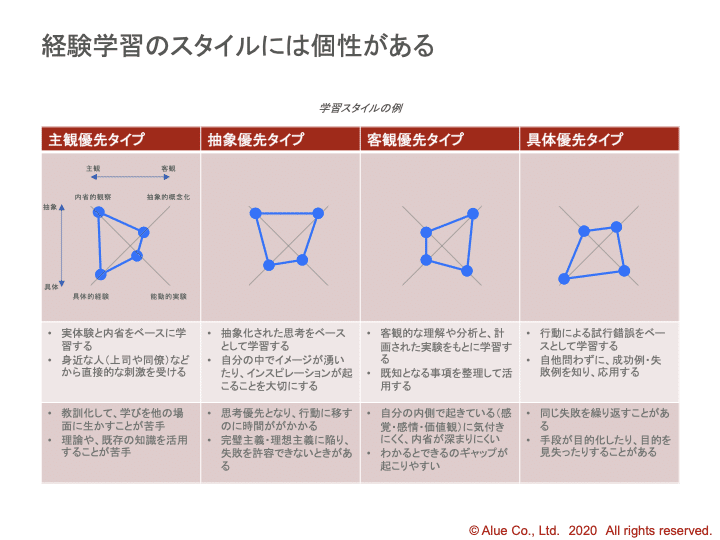
・その部下や後輩の経験学習サイクルがうまく回るためには、どのような支援をすると良さそうでしょうか?(部下や後輩がいない場合、自分の経験学習をさらによく回すためにはどうすればいいかを考えてみてください)
To be a partner in guiding the learning of others
In my previous article, we discussed a model of people development, focusing on the "ability of personal growth" (the ability to learn from experience). We also discussed the importance of how to develop the ability of personal growth of subordinates when it comes to their development.
Once the "foundation," so to speak, has been laid, it is time to start providing concrete support. From this point forward, I would like to assume that we will be dealing with the adaptive challenges of our subordinates. It is also important to deal with technical challenges, but since there are many books on subordinate development that deal with this point, I would like to leave it to those books.
The process of facing and working with subordinates to address their adaptive challenges can be a long road. There is no "just do this and it will be solved" method. (If there were, it would be a "technical challenge" rather than an "adaptive challenge.)
In order to face the adaptive challenges of our subordinates, it is important to imagine the story of overcoming the adaptive challenges.
Foreshadowing future stories
Overcoming adaptive challenges" is nothing more than the process of overcoming the conflict of being held in a state of contradiction. The nature of the contradiction varies from person to person and from situation to situation, but I believe that there is a common story of overcoming.
One archetype for that story is mythologist Joseph Campbell's "The Hero's Journey. Myths from around the world share a common pattern, which is illustrated in the following diagram.

The archetype of story will help us to visualize how the process will go beyond adaptive challenges, what challenges are likely to be involved in the process, and what kind of environment and support will be needed to overcome these challenges. To learn more, please also refer to the following articles.
Of course, things do not always go as envisioned, and I am not suggesting that we should control things in that way. Nevertheless, by keeping a bird's-eye view of where we are in the overall "journey" and what aspects are likely in the future, we can better guide our subordinates in a natural way toward the desired direction without being shortsighted.
Experiential learning cycle
Keeping an image of the subordinate's growth story through the "Hero's Journey" can be seen as a macro and bird's eye view approach.
For a more micro approach, it is important to design "experiences and questions. For this purpose, it is useful to understand the concept of the "experience learning cycle.
The experiential learning cycle is a learning model reconstructed by Kolb based on previous research, in which learning is facilitated by the cyclical progression of four elements, each of which consists of two axes: subjective and objective, concrete and abstract.
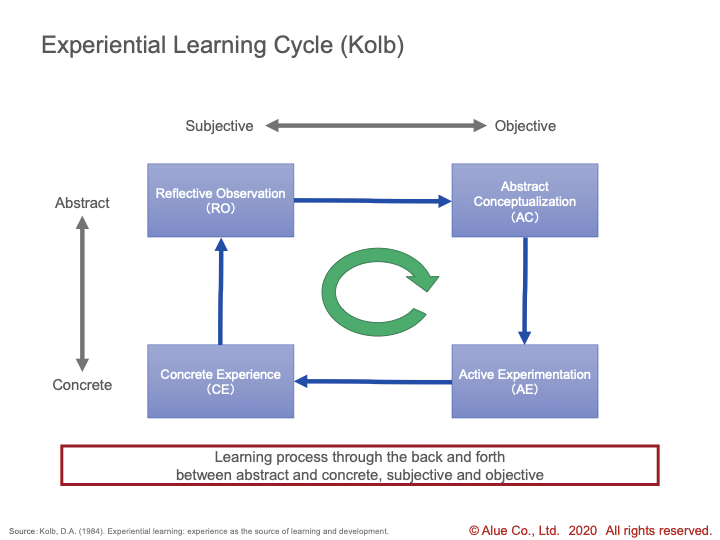
When the experiential learning cycle is functioning, the following processes are spinning.
Subjective x Concrete (lower left)
Subjectively perceive sensations and thoughts from actual experience of some event
↓
Subjective x Abstract (upper left)
Reflecting on a concrete experience and giving it meaning for oneself
↓
Objective x Abstract (upper right)
Obtain suggestions that can be applied, such as understanding the cause-and-effect relationship of events that occurred, or forming a pattern of success or failure stories
↓
Objective x Concrete (lower right)
Verify implications as hypotheses in real-life experiences
↓
Subjective x Concrete (lower left)
Subjectively capture the experience gained from it again
Support subordinates according to their learning styles
The experiential learning cycle, as the name "cycle" implies, is about rotating the four quadrants as coherently as possible. However, each person has his or her own learning style, and within these four quadrants, there are strong parts (that can be practiced naturally) and weak parts (that cannot be practiced naturally). As an example, the following diagram illustrates the four types.
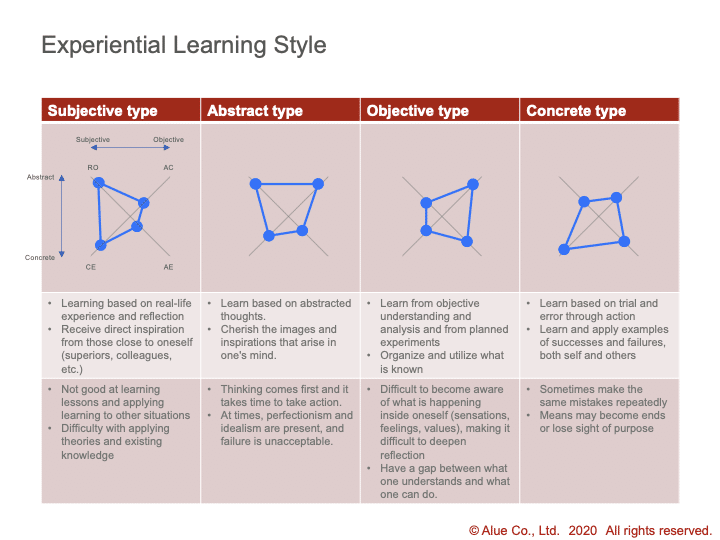
Which type are you closer to? For me, I am the abstract type. While I can practice reflective observation and abstract conceptualization in my daily life without any hesitation, there are times when it takes me a long time to take action, or when I fall into perfectionism and failures are unacceptable.
In people development, we observe which type of people we are developing and try to help them achieve a good balance.
For example, for the "subjective type," we provide support for abstracting past experiences. It is also effective to encourage them to make it a habit to write down their experiences and what they have learned from them.
Or, if they are the "abstract type," we can encourage them to increase their concrete actions. For example, we can encourage them to lower the bar by saying, "It's an experiment for learning, so there's nothing wrong if you fail."
The Importance of "Questions" in Experiential Learning
It is important to have questions to facilitate effective experiential learning.
Questions are closely related to the purpose of experiential learning. For example, if a person is faced with the challenge of listening to the true needs of customers, the question could be, "How can I understand the true needs and desires of my customers?" In this way, questions that are connected to the desired image and wishes are put into the form of concrete questions as much as possible.
When the "question" is clear, the sensors that receive information through daily experiences are strengthened, and the experiential learning cycle is more likely to rotate. If we were to place the "question" in the experiential learning cycle, it would be in the middle of the cycle.
As a specific support, it is a good idea to have a dialogue with subordinates about what kind of "questions" they should have in mind as they work. It may be easier to understand if you clarify the "scene" and the "question" as a set. In the example above, while having a dialogue with subordinates, it is important to clarify the situation of "business meeting with a customer" with a question, "How can I receive the true needs and thoughts of the customer?
As the experiential learning cycle continues, the answer to the question will gradually emerge. Once that happens, we will generate the next "question." We should consider the "question" as something that is constantly evolving, and ask our subordinates to be aware of the "question" for their learning.
The "depth" of experiential learning
Furthermore, the process of experiential learning also has a "depth" perspective. It is the image of what was initially a "dot" becoming more multifaceted and holistic as a line, surface or three-dimensional.

Let us consider the depth of experiential learning from an example of "a customer making a complaint."
A " dot (fragmented)" learning would be to "try to eliminate the mistake." This is an embodiment of learning directly from experience.
In the "line (continuity/relationship)" learning, which is a step deeper, for example, "standardize operations to prevent mistakes from occurring" takes place. The process of experience that a mistake occurred is captured in a "line" (in this case, a cause-and-effect relationship).
At a deeper " surface (complexity)," the learning occurs, for example, "review the organizational culture that disregards operations. We see the background of the phenomenon structurally and become aware of the " sense of value" that is the root cause.
Viewing experiences in connection with "wishes"
Up to the " dot, line, and surface" level of experiential learning, things were viewed objectively as "external phenomena. However, in experiential learning at the "three-dimensional" level, "external phenomena" are viewed in connection with "wishes," in other words, "what one truly desires. For example, one of my own "wishes" is "to create an environment in which employees can work happily. Therefore, I cannot tolerate any measures that "sacrifice the happiness of employees" when addressing some challenge.
In the previous example, when the problem is "an organizational culture that disregards operations," it is necessary to look back and see where this is derived from one's own sense of values. In my case, I had the idea of "trying things out first. By thinking of trial and error as a good thing, I had an aspect of thinking that it was good to continue trial and error even in situations where operations and systems were not fully established.
However, I realized that this way of thinking was contrary to "creating an environment in which employees can work happily. At that time, I needed to consider which one is my true wish, and give priority to my true wish and change the one that is not.
Normally, it is not easy to change one's " sense of value," but when one is aware of his/her "wish," he/she will be willing to change his/her "sense of value.
Therefore, when facing an adaptive challenge that requires transforming one's sense of values level, while it is fundamental to view it at the "surface" level as the depth of experiential learning, it is sometimes necessary to view it at the "three-dimensional" level as well.
In this article, I discussed the importance of supporting subordinates in their experiential learning cycle and how to be a partner in guiding their experiential learning.
Here are the quests of the day. (If you'd like, please share your thoughts in the comments.)
・Which of the following types is closest to the learning style of your subordinates or junior staff members? (If you have no subordinates or juniors, consider your own style)

・What kind of support could you provide to help that subordinate or junior staff member to make the experiential learning cycle work better? (If you don't have a subordinate or junior staff member, think about what you can do to make your own experiential learning cycle go even better.)
Bunshiro Ochiai
この記事が気に入ったらサポートをしてみませんか?
